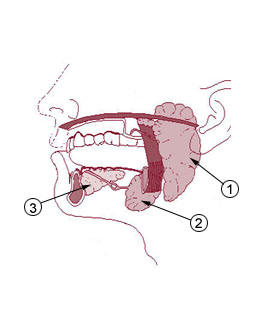Salivary gland facts for kids
Your salivary glands are special parts of your body that make saliva, also known as spit. Saliva does many important jobs. It keeps your mouth and other parts of your digestive system wet and smooth. Saliva also helps to start breaking down your food while you chew. This makes it easier for food to slide down your throat and into your stomach.
You have three main pairs of salivary glands. These are the parotid glands, the submandibular glands, and the sublingual glands. Besides these main ones, there are also many tiny glands. These smaller glands are found in your tongue, cheeks, lips, and the roof of your mouth (your palate). All of these glands work together to produce different types of saliva.
Contents
What is Saliva Made Of?
Saliva is made of two main types of fluid: mucous and serous fluid. Each type has a special role in your body.
Mucous: The Slippery Protector
Mucous is a thick, slippery fluid. It is made from a special sugar-protein mix called mucin. When mucin mixes with water, it creates a smooth, lubricating slime. This slime helps to coat and protect many parts of your body. In your mouth, it makes sure your throat and alimentary canal (the tube food travels through) stay slippery.
Mucous also acts like a bodyguard for your mouth. It contains special germ-fighting parts like lysozyme and immunoglobulins. These parts help to trap and fight off tiny invaders. They can catch fungi, bacteria, and viruses. This helps to stop infections from starting in your mouth. Your body makes about a liter of mucous every day.
Serous Fluid: The Digestion Helper
The serous fluid in your saliva contains an important helper called amylase. Amylase is an enzyme, which is a special protein that speeds up chemical reactions. This enzyme starts to break down carbohydrates in your food. Carbohydrates are things like sugars and starches.
Some small salivary glands on your tongue make amylase. The parotid glands, which are the largest, make only serous saliva. The other main salivary glands make a mix of both serous and mucous saliva.
Different Types of Salivary Glands
Each of your main salivary glands makes a slightly different type of saliva:
- The parotid glands produce only serous fluid. This fluid is watery and full of the amylase enzyme.
- The submandibular glands are mixed glands. They create both serous and mucous fluids.
- The sublingual glands mostly make mucous. This makes their saliva thicker and more slippery.
How Salivary Glands Are Built
Your salivary glands are protected by a covering called a capsule. This capsule is made of connective tissue. Inside the capsule, the glands are divided into smaller sections called lobules. Tiny blood vessels and nerves run into these lobules.
There are three main types of cells that make up your major salivary glands:
- Serous cells are shaped like tiny pyramids. They group together in a ball-like shape.
- Mucous cells are usually shaped like cubes. They join together to form very small tubes called tubules.
- Myoepithelial cells surround the parts of the gland where saliva is made. These cells can squeeze the gland. This helps to push the saliva out faster.
The small tubes from these cells connect to bigger tubes called ducts. These ducts then join even larger ducts that have little stripes on them. Finally, the main duct from each salivary gland opens directly into your mouth.
Where Are Your Salivary Glands Located?
You have three main pairs of salivary glands, each in a specific spot:
- The two parotid glands are the largest salivary glands. They are located near your ear. The name "parotid" actually means "next to the ear."
- The sublingual glands are found right under your tongue.
- The submandibular glands are shaped like a "U." They are located under your chin bone, which is called the mandible.
Images for kids
-
Micrograph of chronic inflammation of the salivary gland (sialadenitis)
See also
 In Spanish: Glándula salival para niños
In Spanish: Glándula salival para niños



